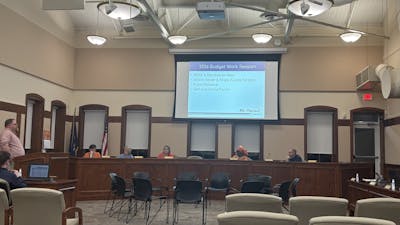Music faculty using virtual reality technology to improve students’ performance abilities

Virgina senior Riley Anderson uses a virtual reality headset to practice his euphonium. Though he is sitting in a School of Music office, he sees the Staples Family Concert Hall through a 360 degree photo. (Courtesy Photo | CMU School of Music Facebook page)
Time and time again, Central Michigan University School of Music faculty Mark Cox has seen students underperform at recitals, concerts and competitions simply because they were taken aback by the sound of the large space they had to play in. Students would also play too softly for the space, as they were used to practicing their pieces in small practice rooms.
Cox struggled to find a solution to this problem at first – but thanks to his love of technology, he found one: Virtual reality.
“I [found] a program called AltiSpace, and you can recreate all sorts of hall sounds in it,” Cox said. “One of my students who's an IT major and a music minor said, ‘Well, you've got VR goggles. Why don't you just do VR with it so that you can see?’ And I'm like, ‘What a great idea!’ So that kind of got me started down the road.”
Cox uses his phone, equipped with AltiSpace and 360 degree photos in the Google Cardboard app, to simulate the aural and visual components of playing in a concert hall. He uses this setup to practice for his own performances, and he has begun to introduce the technology to some of his students.
One of those students is Virginia senior Riley Anderson, a euphonium player under Cox. Anderson says that the system has improved Cox's live-playing in a short amount of time.
“Many of us, including me, have struggled with playing out, playing louder,” Anderson said. “As soon as (Cox) started using this whole AltiSpace system with us, he’s been able to get players like me and even the younger players to play out a lot faster.”
Cox himself has noticed Anderson’s improvements due to the system, and he is not the only one.
Anderson participated in a concerto competition recently, in which he had to play in the Staples Family Concert Hall. He practiced with the VR system for three weeks before the competition and ended up making it into the finals.
Another student of Cox’s, tuba player and Illinois junior Anthony Escalante has been involved with the system on a deeper level. Escalante teamed up with Cox to combine the functions of both AltiSpace and Google Cardboard in a single application.
“Honestly the project can be however big or small I’m able to make it,” Escalante said. “You can have the range of complete void where you get nothing back to grand hall where it takes thirty seconds for your sound to finally disappear because that’s what some halls do. We want to try and simulate that through the application.”
Escalante has high hopes for the application, and he’d like to finish it before he graduates in 2020. He said that he would like users to be able to adjust the reverberation, echo timing, echo strength and the bass, tenor, and master volume of their environment.
The technology is certainly helpful to those in the music program, but Anderson thinks that it could be used by individuals in other areas.
“I can see (the application) being used with private instructors or college teachers that have students that struggle with playing out,” said Anderson. “I can probably even see it being used in communication classes, because learning to speak out is also a skill, so I think using a device like that could be very helpful for students.
"I can see it being used beyond music.”
While the full program is still a long way from completion, Cox wants to ensure that musicians and others know that his present system, being made up of two apps and a cheap VR headset, is affordable and easy to use.
Due to the affordability of this combination, Cox thinks that it could be used all over to help individuals overcome anxiety when playing in spaces they aren’t used to.
“Let's say that the Youth Arts Michigan State Band Orchestra Association said, ‘Hey, you're going to be at CMU, you're going to be in this hall," he said. "Here's a picture of it.’ You could put it in your phone and at least get used to the visual...so that when you walk out onstage you’re not awestruck.
"It's still nerve-racking, don't get me wrong, you've still got judges sitting out there and everything but (without) the ‘Oh my gosh, look at this place,’ sort of effect.”






